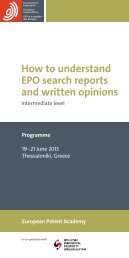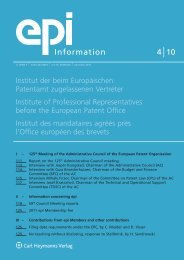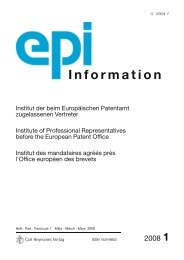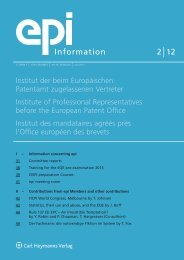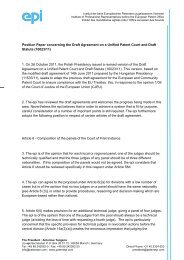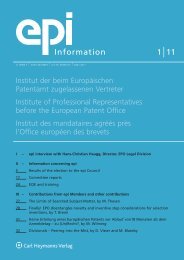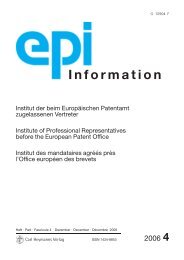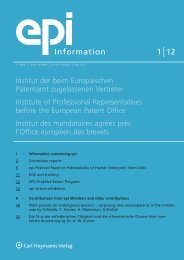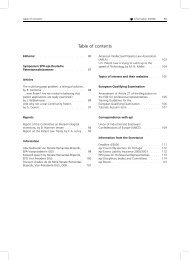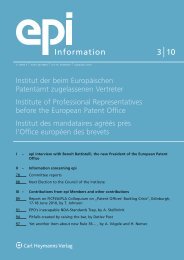epi Information 2/2009
epi Information 2/2009
epi Information 2/2009
You also want an ePaper? Increase the reach of your titles
YUMPU automatically turns print PDFs into web optimized ePapers that Google loves.
64 Articles <strong>Information</strong> 2/<strong>2009</strong><br />
iners, representatives and technical experts in firms.<br />
There would be a corresponding, and important,<br />
increase in patent quality, together with greatly reduced<br />
uncertainty for third parties.<br />
If we consider a typical European Patent that is<br />
allowed to lapse ten years after its priority date,<br />
Expedited Examination would mean that the granted<br />
patent would be in force for the final eight years of that<br />
period, and would only have been an application for the<br />
first two years. This is a much more desirable situation<br />
than an application that pends for four and a half years,<br />
and then is in force for five and a half years.<br />
„It is a truth universally acknowledged …“<br />
or<br />
Double patenting and the EPC<br />
D. Harrison (GB) 1 and T. Bremi (CH) 2<br />
The quoted words are the famous opening of Jane<br />
Austen’s „Pride and Prejudice“. She was writing about<br />
the evident need for a moneyed bachelor to have a wife.<br />
There are complications, but it all ends happily.<br />
The subject here is double patenting – there are<br />
certainly complications and it may not end happily, but<br />
it also has in common a universal acknowledgment, in<br />
this case that it is a Bad Thing. Such acknowledgments<br />
have the uncomfortable tendency to suffer by virtue of<br />
their universality from a lack of investigation into the<br />
veracity of that „truth“.<br />
Everyone agrees that double patenting is an evil; but<br />
ask what it is, and why it is bad, and you do not usually<br />
get a coherent answer.<br />
To start with, it is notoriously not stated in the EPC<br />
what you do if faced with – adopting a provisional<br />
definition for the sake of argument – two applications<br />
from the same source, of the same date, and relating to<br />
the same invention. The original Travaux Préparatoires of<br />
the Convention are rather unhelpful; there seems to<br />
have been universal acknowledgment that double patenting<br />
(without deciding what it was) was deplorable to<br />
the extent that it was felt unnecessary to legislate against<br />
it in the EPC! 3 The only specific discussion in the Travaux<br />
Préparatoires in this respect however seems to be in<br />
relation with Art. 139, dealing with the conflict of European<br />
patents with national patents. There it is expressly<br />
stated that the permission or prohibition of simultaneous<br />
protection could be left to each of the contracting<br />
states, 4 and in 1972 the Conference decided to retain<br />
the rights for the contracting states to provide for<br />
simultaneous protection. 5 As the coexistence of the<br />
European and the National systems is a heavily political<br />
issue, the discussion around Art. 139 can however not<br />
be directly compared with the conflict between two<br />
European patents. The question does not seem to have<br />
been discussed during the 2000 revision.<br />
We get some, but not very consistent, guidance from<br />
the case-law and the Guidelines.<br />
The Case-Law<br />
The Boards of Appeal of the EPO had never until very<br />
recently directly confronted the question of double patenting.<br />
There is a reference in T 0441/92, but a much<br />
fuller and more interesting discussion in T 587/98, where<br />
the question was whether a divisional application could<br />
have a main claim which was wider than, and completely<br />
included, the main claim of its parent. The divisional had<br />
been refused by the examining division on the basis of<br />
Article 125 EPC: there was allegedly a „general principle“<br />
in the contracting states that double patenting –<br />
which the Examining Division, without attempting any<br />
definition, took this to be an example of – was not<br />
allowable.<br />
The Board did not have much difficulty with this;<br />
Article 125 relates to procedural matters and this is<br />
substantive (Reasons 3.6; see also T 307/03, Reasons<br />
2.7, last sentence), but it dealt also with the substance,<br />
pointing out in Reasons 3.4;<br />
„Given that this kind of „overlap“ is not prohibited under<br />
the EPC in the situations outlined immediately above<br />
[namely an Article 54(3) scenario], it is not apparent to<br />
the board why it should be prohibited between divisional<br />
and parent applications. It may perhaps be thought that<br />
such a prohibition is desirable to prevent the proliferation<br />
of patents for obvious variants, but it would appear<br />
invidious to make a distinction between copending<br />
applications in an Article 54(3) EPC relationship and<br />
1 European Patent Attorney, Mewburn Ellis LLP, GB; E-mail: david.harrison6@ukonline.co.uk<br />
2 European Patent Attorney, Isler & Pedrazzini AG, CH; E-mail: tobias.bremi@islerpedrazzini.ch<br />
3 Travaux Préparatoires, 3076/IV/62-D, page 115, first paragraph: … weil die<br />
Arbeitsgruppe vom Koordinationsausschuss angehalten worden sei, vom<br />
grundsätzlichen Verbot der Patenthäufung auszugehen…<br />
4 Travaux Préparatoires, BR/7 e/69 kel/PA/mk, page 8 5 Travaux Préparatoires, BR/168 e/72 oyd/KM/gc, page 9



